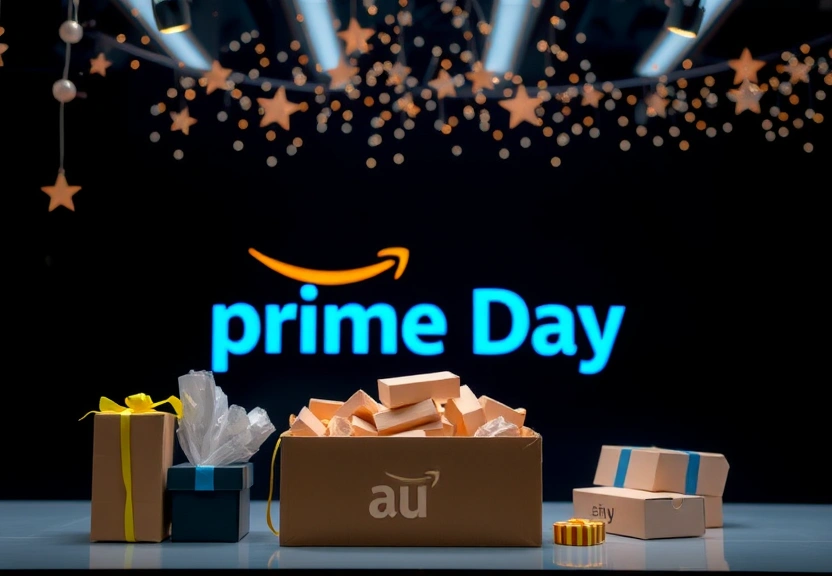Is Amazon Prime Day Losing Its Magic? Early Data Reveals Declining Shopper Spending
Amazon Prime Day, once hailed as a groundbreaking retail event, has transformed from a single-day shopping frenzy into a sprawling four-day spectacle. Designed to boost sales and enhance customer loyalty, this event has historically generated immense enthusiasm among consumers. However, early data from this year’s event suggests a concerning trend: declining shopper spending and a noticeable dip in consumer enthusiasm. As retailers and consumers alike analyze the impact of this year’s Prime Day, several key factors will determine whether this once-thriving sales event can regain its former glory.

In this article, we will explore the implications of early sales trends, the changing landscape of retail events, and what this means for consumers and businesses alike. As we delve into the nuances of Amazon Prime Day, we will evaluate its role in shaping the future of online shopping and discuss strategies that may help restore the magic that once defined this event.
Understanding the Current Landscape of Amazon Prime Day
Amazon Prime Day’s evolution from a single-day sale to a multi-day event reflects the company’s desire to create a shopping holiday that rivals Black Friday and Cyber Monday. However, as consumer behavior shifts and competition intensifies, the effectiveness of such promotional strategies is increasingly called into question. To better understand the current landscape, we need to consider several factors influencing shopper spending and overall consumer enthusiasm.
The Rise of Competitors
One significant factor contributing to the potential decline of Amazon Prime Day is the emergence of competing retail events. Major retailers, including Walmart, Target, and Best Buy, have started to launch their own sales events in July, aiming to capture the attention of consumers during this lucrative shopping window. These competing promotions not only dilute the impact of Amazon Prime Day but also give consumers more options, leading to a potential decrease in spending on Amazon’s platform.
Shifting Consumer Priorities
Another important aspect to consider is the changing priorities of consumers. As inflationary pressures and economic uncertainties continue to weigh on households, many shoppers are becoming more cautious with their spending. The focus has shifted from impulse purchases to essential items, which may not necessarily align with the typically discounted products found on Prime Day. This shift in consumer behavior indicates a potential mismatch between Amazon’s promotional strategy and the current needs of its customer base.
Analyzing Shopper Spending Trends
Early data from this year’s Amazon Prime Day indicates a decline in shopper spending compared to previous years. Key metrics such as total sales volume, average order value, and the number of transactions all point towards a less enthusiastic response from consumers. Understanding these trends is critical for both retailers and consumers as they navigate the evolving retail landscape.
Sales Volume Decline
Reports have shown that the total sales volume generated during this year’s Prime Day fell short of expectations. While Amazon typically sees a surge in sales during this event, preliminary figures suggest a significant decrease in overall revenue. This decline raises questions about the effectiveness of Amazon’s promotional strategies and the event’s ability to drive consumer interest.
Average Order Value Trends
Another concerning trend is the decrease in average order value. In previous years, consumers were driven to purchase multiple items, often taking advantage of bundled deals and significant discounts. However, this year’s data reveals that shoppers are opting for fewer items, indicating a more cautious approach to spending. This change could be attributed to economic factors and shifting priorities, which are prompting consumers to rethink their purchases.
The Importance of Consumer Enthusiasm
Consumer enthusiasm is a crucial driver of sales during any major retail event, including Amazon Prime Day. A lack of excitement can lead to reduced engagement and lower spending, ultimately impacting sales figures. Understanding what drives consumer enthusiasm is essential for Amazon and other retailers looking to capitalize on this significant shopping event.
Marketing and Promotion Strategies
One aspect that can significantly influence consumer enthusiasm is the effectiveness of marketing and promotional strategies. Amazon has historically relied on aggressive marketing tactics, including targeted advertising and exclusive deals for Prime members. However, if consumers perceive these promotions as less valuable or engaging, their enthusiasm may wane. Retailers must continually innovate their marketing approaches to capture and maintain consumer interest.
Consumer Experience and Satisfaction
The overall shopping experience also plays a vital role in fostering consumer enthusiasm. If shoppers encounter difficulties such as website outages, slow shipping times, or inadequate customer service, their enthusiasm can quickly diminish. Ensuring a seamless and positive shopping experience is essential for maintaining consumer interest and encouraging repeat purchases during events like Prime Day.
Key Takeaways for Retailers and Consumers
The early data from this year’s Amazon Prime Day serves as a wake-up call for both retailers and consumers. Here are some important points to consider:
- Monitor competitor activities: Retailers should be aware of competing sales events and adjust their strategies accordingly to maintain consumer interest.
- Understand changing consumer behavior: Staying attuned to consumer priorities and preferences is essential for crafting effective promotions.
- Focus on marketing innovation: Retailers must continually seek new ways to engage consumers and differentiate their offerings from competitors.
- Enhance the shopping experience: Providing a seamless and enjoyable shopping experience is crucial for fostering consumer enthusiasm and loyalty.
- Adapt to economic conditions: Retailers should remain flexible in their promotional strategies, ensuring they align with the current economic landscape and consumer expectations.
Frequently Asked Questions (FAQs)
1. What is Amazon Prime Day?
Amazon Prime Day is an annual shopping event exclusive to Amazon Prime members, featuring significant discounts on a wide range of products. The event has evolved from a single day to a multi-day sale, designed to drive sales and enhance customer loyalty.
2. Why are shoppers spending less during Prime Day this year?
Shoppers may be spending less due to a combination of factors, including increased competition from other retailers, changing consumer priorities, and economic uncertainties, which have made consumers more cautious with their spending.
3. How does Amazon Prime Day compare to Black Friday?
While both events offer significant discounts, Amazon Prime Day is specifically geared toward Prime members and typically occurs in July, whereas Black Friday takes place in late November and is a broader retail event involving multiple retailers.
4. What strategies can retailers implement to improve sales during Prime Day?
Retailers can improve sales by monitoring competitor activities, understanding changing consumer behavior, innovating marketing strategies, enhancing the shopping experience, and adapting to current economic conditions.
5. Will Amazon Prime Day continue to be a significant retail event in the future?
While its significance may be challenged by declining shopper spending and competition, Amazon Prime Day has the potential to remain relevant if it adapts to changing consumer needs and maintains effective promotional strategies.
Conclusion
As Amazon Prime Day continues to evolve, the early data indicating declining shopper spending and consumer enthusiasm raises important questions about the future of this once-magic retail event. With increasing competition and shifting consumer priorities, retailers must adapt their strategies to meet the needs of today’s shoppers. By focusing on innovative marketing, enhancing the shopping experience, and remaining attuned to economic realities, Amazon and other retailers can work towards rekindling the excitement that once defined Prime Day. Ultimately, the success of this event will depend on its ability to resonate with consumers and align with their evolving preferences.
📰 Original Source
Este artigo foi baseado em informações de: https://www.marketwatch.com/story/is-amazons-prime-day-sale-losing-its-appeal-some-early-data-suggest-shoppers-are-spending-less-this-year-ac365fbb?mod=mw_rss_topstories


